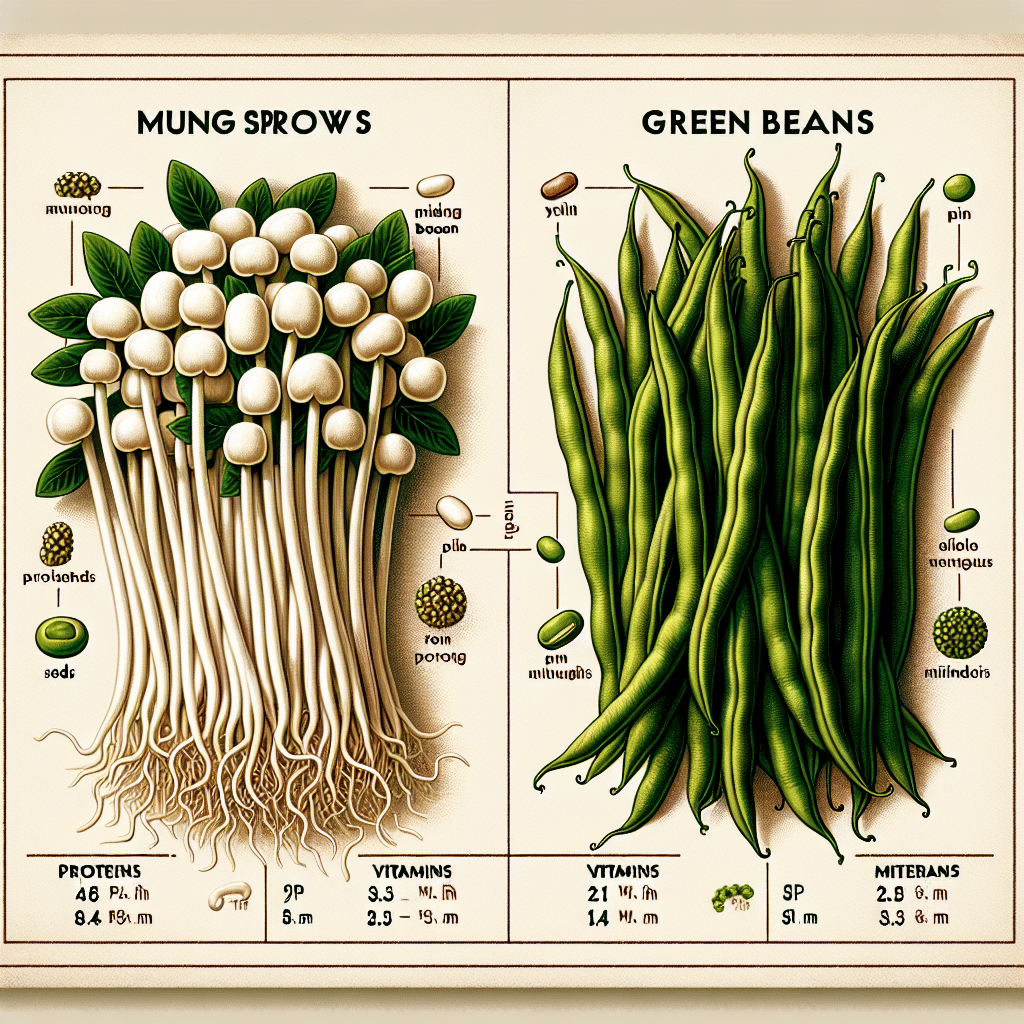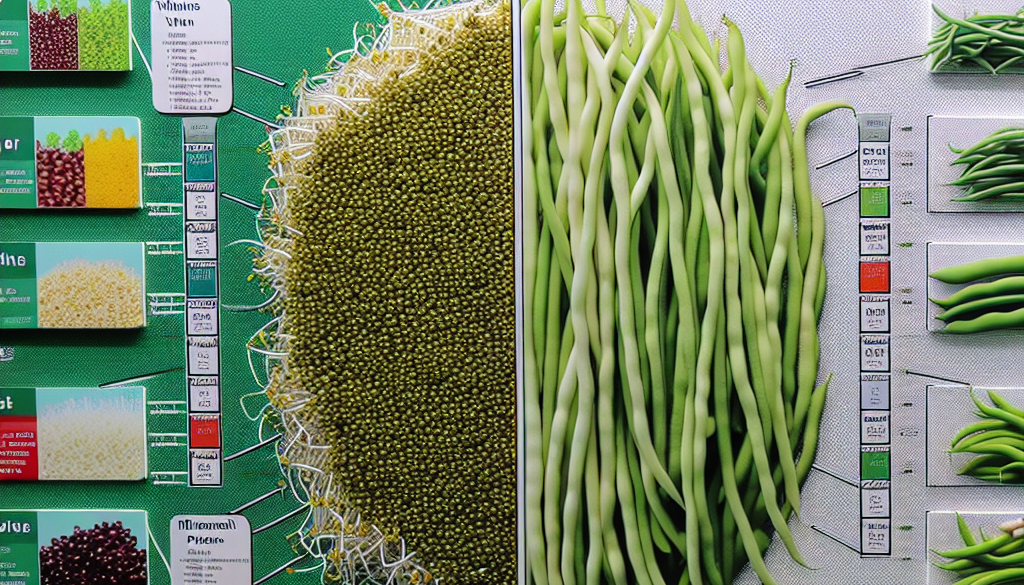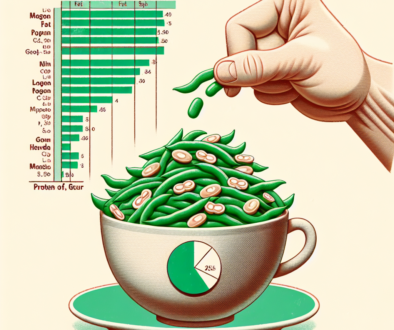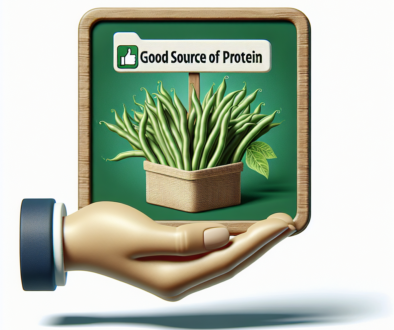Mung Bean Sprouts vs. Green Beans: Nutritional Value
-
Table of Contents
- Mung Bean Sprouts vs. Green Beans: A Nutritional Comparison
- Introduction to Mung Bean Sprouts and Green Beans
- Nutritional Profiles of Mung Bean Sprouts and Green Beans
- Mung Bean Sprouts
- Green Beans
- Health Benefits of Mung Bean Sprouts and Green Beans
- Health Benefits of Mung Bean Sprouts
- Health Benefits of Green Beans
- Comparative Analysis of Nutritional Value
- Protein Content
- Vitamin and Mineral Density
- Fiber Comparison
- Caloric Value
- How to Incorporate Mung Bean Sprouts and Green Beans into Your Diet
- Mung Bean Sprouts
- Green Beans
- Conclusion: Making the Right Choice for Your Diet
- Discover ETprotein’s High-Quality Protein Products
Mung Bean Sprouts vs. Green Beans: A Nutritional Comparison

When it comes to choosing healthy vegetables, the options can be overwhelming. Among the plethora of choices, mung bean sprouts and green beans stand out for their nutritional benefits and versatility in the kitchen. This article delves into the nutritional profiles of these two popular plant foods, comparing their vitamins, minerals, and health benefits to help you make an informed decision about which to include in your diet.
Introduction to Mung Bean Sprouts and Green Beans
Mung bean sprouts are germinated mung beans commonly used in Asian cuisine. They are known for their crisp texture and slightly sweet flavor. Green beans, also known as string beans or snap beans, are the unripe fruit and protective pods of various cultivars of the common bean (Phaseolus vulgaris). They are enjoyed worldwide and can be eaten raw or cooked.
Nutritional Profiles of Mung Bean Sprouts and Green Beans
Both mung bean sprouts and green beans are low in calories and rich in nutrients. Here’s a closer look at what each has to offer:
Mung Bean Sprouts
- Calories: Low in calories, making them a great addition to weight-loss diets.
- Protein: A good source of plant-based protein, essential for muscle repair and growth.
- Fiber: High in dietary fiber, which aids in digestion and promotes a feeling of fullness.
- Vitamins: Rich in Vitamin C, Vitamin K, and B vitamins, including folate.
- Minerals: Contains minerals such as iron, magnesium, potassium, and phosphorus.
- Antioxidants: Offers antioxidants that help protect the body from oxidative stress.
Green Beans
- Calories: Also low in calories, contributing to a healthy diet.
- Protein: Contains a moderate amount of protein for a vegetable.
- Fiber: Provides dietary fiber, which supports digestive health.
- Vitamins: A good source of Vitamin A, Vitamin C, Vitamin K, and several B vitamins.
- Minerals: Offers minerals like calcium, iron, magnesium, and potassium.
- Phytonutrients: Contains phytonutrients that may have anti-inflammatory properties.
Health Benefits of Mung Bean Sprouts and Green Beans
Both mung bean sprouts and green beans offer a range of health benefits due to their nutrient content. Here are some of the key advantages of including these vegetables in your diet:
Health Benefits of Mung Bean Sprouts
- Weight Management: Their low-calorie content and high fiber can help in weight control.
- Heart Health: The potassium and fiber in mung bean sprouts can contribute to heart health.
- Immune Support: Vitamin C content supports the immune system.
- Blood Sugar Control: Their low glycemic index makes them suitable for people with diabetes.
- Bone Health: Vitamin K is essential for bone health and wound healing.
Health Benefits of Green Beans
- Eye Health: Vitamin A and carotenoids in green beans can support eye health.
- Antioxidant Effects: The antioxidants in green beans may reduce the risk of chronic diseases.
- Heart Health: Fiber, potassium, and other nutrients contribute to cardiovascular health.
- Anti-inflammatory Properties: Phytonutrients in green beans may help reduce inflammation.
- Preventive Effects: Regular consumption may help prevent certain forms of cancer.
Comparative Analysis of Nutritional Value
When comparing mung bean sprouts and green beans, it’s important to consider your dietary needs. Mung bean sprouts are higher in protein and Vitamin C, while green beans offer more Vitamin A and calcium. Both are excellent sources of fiber and other essential nutrients.
Protein Content
Mung bean sprouts typically have a higher protein content compared to green beans, making them a preferred choice for vegetarians and vegans looking to increase their protein intake.
Vitamin and Mineral Density
Green beans have a slight edge in terms of Vitamin A content, which is crucial for vision and immune function. However, mung bean sprouts excel in Vitamin C, essential for collagen production and immune defense.
Fiber Comparison
Both vegetables are high in fiber, though mung bean sprouts may have a higher fiber content per serving, which can be beneficial for digestive health and satiety.
Caloric Value
Both mung bean sprouts and green beans are low in calories, but sprouts tend to be slightly lower, making them a slightly better option for calorie-conscious individuals.
How to Incorporate Mung Bean Sprouts and Green Beans into Your Diet
Both mung bean sprouts and green beans are versatile and can be included in a variety of dishes. Here are some ideas:
Mung Bean Sprouts
- Add to salads for a crunchy texture.
- Include in stir-fries with other vegetables and a protein source.
- Use as a topping for sandwiches or wraps.
- Incorporate into spring rolls or sushi rolls.
Green Beans
- Steam or sauté as a side dish with herbs and spices.
- Mix with other vegetables in a hearty stew or casserole.
- Blanch and add to salads for a pop of color and nutrients.
- Pickle for a tangy snack or addition to appetizer platters.
Conclusion: Making the Right Choice for Your Diet
In conclusion, both mung bean sprouts and green beans offer unique nutritional benefits and can be excellent additions to a balanced diet. The choice between them may come down to personal preference, dietary needs, or specific health goals. By understanding their nutritional profiles and health benefits, you can make an informed decision that aligns with your wellness journey.
Discover ETprotein’s High-Quality Protein Products
If you’re looking to enhance your diet with additional protein sources, consider exploring ETprotein’s range of organic bulk vegan protein products. Their selection includes mung bean protein, which can complement the nutritional benefits of mung bean sprouts and green beans in your diet.
About ETprotein:
ETprotein, a reputable protein Chinese factory manufacturer and supplier, is renowned for producing, stocking, exporting, and delivering the highest quality organic bulk vegan protein and plant proteins. They include Organic rice protein, clear rice protein, pea protein, clear pea protein, pumpkin seed protein, sunflower seed protein, mung bean protein, etc. Their offerings, characterized by a neutral taste, non-GMO, allergen-free attributes, cater to a diverse range of industries. They serve nutraceutical, pharmaceutical, cosmeceutical, veterinary, as well as food and beverage finished product distributors, traders, and manufacturers across Europe, USA, Canada, Australia, Thailand, Japan, Korea, Brazil, and Chile, among others.
ETprotein specialization includes exporting and delivering tailor-made protein powder and finished nutritional supplements. Their extensive product range covers sectors like Food and Beverage, Sports Nutrition, Weight Management, Dietary Supplements, Health and Wellness Products, and Infant Formula, ensuring comprehensive solutions to meet all your protein needs.
As a trusted company by leading global food and beverage brands and Fortune 500 companies, ETprotein reinforces China’s reputation in the global arena. For more information or to sample their products, please contact them and email sales(at)ETprotein.com today.












